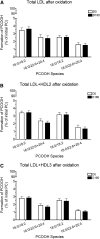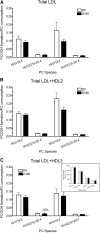Statin action enriches HDL3 in polyunsaturated phospholipids and plasmalogens and reduces LDL-derived phospholipid hydroperoxides in atherogenic mixed dyslipidemia
- PMID: 27581680
- PMCID: PMC5087874
- DOI: 10.1194/jlr.P068585
Statin action enriches HDL3 in polyunsaturated phospholipids and plasmalogens and reduces LDL-derived phospholipid hydroperoxides in atherogenic mixed dyslipidemia
Abstract
Atherogenic mixed dyslipidemia associates with oxidative stress and defective HDL antioxidative function in metabolic syndrome (MetS). The impact of statin treatment on the capacity of HDL to inactivate LDL-derived, redox-active phospholipid hydroperoxides (PCOOHs) in MetS is indeterminate. Insulin-resistant, hypertriglyceridemic, hypertensive, obese males were treated with pitavastatin (4 mg/day) for 180 days, resulting in marked reduction in plasma TGs (-41%) and LDL-cholesterol (-38%), with minor effects on HDL-cholesterol and apoAI. Native plasma LDL (baseline vs. 180 days) was oxidized by aqueous free radicals under mild conditions in vitro either alone or in the presence of the corresponding pre- or poststatin HDL2 or HDL3 at authentic plasma mass ratios. Lipidomic analyses revealed that statin treatment i) reduced the content of oxidizable polyunsaturated phosphatidylcholine (PUPC) species containing DHA and linoleic acid in LDL; ii) preferentially increased the content of PUPC species containing arachidonic acid (AA) in small, dense HDL3; iii) induced significant elevation in the content of phosphatidylcholine and phosphatidylethanolamine (PE) plasmalogens containing AA and DHA in HDL3; and iv) induced formation of HDL3 particles with increased capacity to inactivate PCOOH with formation of redox-inactive phospholipid hydroxide. Statin action attenuated LDL oxidability Concomitantly, the capacity of HDL3 to inactivate redox-active PCOOH was enhanced relative to HDL2, consistent with preferential enrichment of PE plasmalogens and PUPC in HDL3.
Trial registration: ClinicalTrials.gov NCT01595828.
Keywords: antioxidative activity; high density lipoprotein 3; lipidomics; low density lipoprotein; metabolic syndrome disease; oxidative stress; phospholipid hydroxides; pitavastatin.
Copyright © 2016 by the American Society for Biochemistry and Molecular Biology, Inc.
Figures


Similar articles
-
HDL3-mediated inactivation of LDL-associated phospholipid hydroperoxides is determined by the redox status of apolipoprotein A-I and HDL particle surface lipid rigidity: relevance to inflammation and atherogenesis.Arterioscler Thromb Vasc Biol. 2009 Dec;29(12):2169-75. doi: 10.1161/ATVBAHA.109.194555. Epub 2009 Sep 17. Arterioscler Thromb Vasc Biol. 2009. PMID: 19762782
-
Pitavastatin: novel effects on lipid parameters.Atheroscler Suppl. 2011 Nov;12(3):277-84. doi: 10.1016/S1567-5688(11)70887-X. Atheroscler Suppl. 2011. PMID: 22152282 Review.
-
Statin action favors normalization of the plasma lipidome in the atherogenic mixed dyslipidemia of MetS: potential relevance to statin-associated dysglycemia.J Lipid Res. 2015 Dec;56(12):2381-92. doi: 10.1194/jlr.P061143. Epub 2015 Oct 20. J Lipid Res. 2015. PMID: 26486974 Free PMC article.
-
Duality of statin action on lipoprotein subpopulations in the mixed dyslipidemia of metabolic syndrome: Quantity vs quality over time and implication of CETP.J Clin Lipidol. 2018 May-Jun;12(3):784-800.e4. doi: 10.1016/j.jacl.2018.02.001. Epub 2018 Feb 9. J Clin Lipidol. 2018. PMID: 29574070 Clinical Trial.
-
Antiatherogenic function of HDL particle subpopulations: focus on antioxidative activities.Curr Opin Lipidol. 2010 Aug;21(4):312-8. doi: 10.1097/MOL.0b013e32833bcdc1. Curr Opin Lipidol. 2010. PMID: 20581677 Review.
Cited by
-
The Protective Role of Adiponectin for Lipoproteins in End-Stage Renal Disease Patients: Relationship with Diabetes and Body Mass Index.Oxid Med Cell Longev. 2019 Feb 18;2019:3021785. doi: 10.1155/2019/3021785. eCollection 2019. Oxid Med Cell Longev. 2019. PMID: 30911344 Free PMC article.
-
Searching for Atherosclerosis Biomarkers by Proteomics: A Focus on Lesion Pathogenesis and Vulnerability.Int J Mol Sci. 2023 Oct 14;24(20):15175. doi: 10.3390/ijms242015175. Int J Mol Sci. 2023. PMID: 37894856 Free PMC article. Review.
-
The Essence of Lipoproteins in Cardiovascular Health and Diseases Treated by Photodynamic Therapy.Biomedicines. 2024 Apr 26;12(5):961. doi: 10.3390/biomedicines12050961. Biomedicines. 2024. PMID: 38790923 Free PMC article. Review.
-
Changes of plasmalogen phospholipid levels during differentiation of induced pluripotent stem cells 409B2 to endothelial phenotype cells.Sci Rep. 2017 Aug 24;7(1):9377. doi: 10.1038/s41598-017-09980-x. Sci Rep. 2017. PMID: 28839272 Free PMC article.
-
Exploring the Role of a Novel Peptide from Allomyrina dichotoma Larvae in Ameliorating Lipid Metabolism in Obesity.Int J Mol Sci. 2020 Nov 12;21(22):8537. doi: 10.3390/ijms21228537. Int J Mol Sci. 2020. PMID: 33198343 Free PMC article.
References
-
- Baigent C., Blackwell L., Emberson J., Holland L. E., Reith C., Bhala N., Peto R., Barnes E. H., Keech A., Simes J., et al. . 2010. Efficacy and safety of more intensive lowering of LDL cholesterol: a meta-analysis of data from 170,000 participants in 26 randomised trials. Lancet. 376: 1670–1681. - PMC - PubMed
-
- Nicholls S. J., Ballantyne C. M., Barter P. J., Chapman M. J., Erbel R. M., Libby P., Raichlen J. S., Uno K., Borgman M., Wolski K., et al. . 2011. Effect of two intensive statin regimens on progression of coronary disease. N. Engl. J. Med. 365: 2078–2087. - PubMed
-
- Sposito A. C., and Chapman M. J.. 2002. Statin therapy in acute coronary syndromes: mechanistic insight into clinical benefit. Arterioscler. Thromb. Vasc. Biol. 22: 1524–1534. - PubMed
Publication types
MeSH terms
Substances
Associated data
LinkOut - more resources
Full Text Sources
Other Literature Sources
Medical
Miscellaneous

